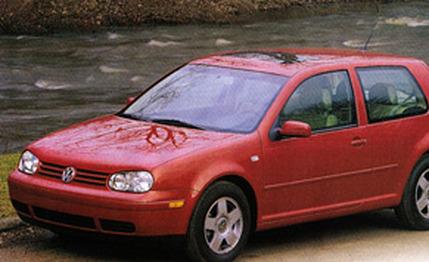
 Short Take Road Test
Short Take Road Test
When the Volkswagen GTI first appeared in late 1982, it was not what it seemed. It looked like just another people's car, which in those days meant nine parts snore to one part roar. But then came the surprise -- this prototypical econobox could scoot to 60 mph quicker than a Trans Am and cut around corners like Walter Payton. Its price was within the grasp of many young people of the day, and it became a favorite of boys and girls alike, the latter loving its ability to blow away annoying dorks in muscle cars.
But like the generation that first embraced it, the GTI matured over the years, losing a lot of its callow cool and performance focus as it grew in weight and size.
The most recent GTI, introduced in 1999 in several versions, doesn't entirely reverse evolution, but it pays homage to the original's style, feel, and no-nonsense competence while tempering it with an overlay of contemporary sophistication and luxury. Based on the fourth generation of Volkswagen's Golf platform -- it also underpins the New Beetle and the Audi TT -- were the base GLS, with a 115-horsepower four-cylinder engine, and the GLX, with VW's compact 174-hp narrow-angle V-6 packed under the hood.
For 2000, the GTI range has been enhanced with the addition of a 1.8-liter, 20-valve turbo four-cylinder that puts out a respectable 150 hp. Otherwise, the GLS is virtually identical to the GLX but for two things: Its 15-inch wheels and tires aren't as grippy as the GLX's 16-inchers, and the GLS, well-equipped at a base price of $19,750, undercuts the GLX by $3395.
Are the V-6's additional 24 hp and 26 pound-feet and revvier sound worth the extra few grand? Not so you'd notice. The V-6 is 0.2 second quicker than the 1.8T at 10-mph increments through 50. At 60 mph, it's 0.4 second ahead and extends its advantage to half a second through the quarter-mile. In real life these few 10ths are imperceptible. In other objective categories, the GLX has an edge on the skidpad (0.85 g to 0.80), thanks to its lower-profile Michelin MXV4s, but in braking and top speed the two GTIs are virtually equal (131 mph and 185 feet from 70 for the GLS vs. 133 mph and 183 feet for the GLX).
Examined subjectively, the GLX feels as though it has a bit more midrange power, but this is an illusion intensified by its racier exhaust note. In fact, the more silent four runs from 30 to 50 mph in 8.4 seconds, 1.6 quicker than the V-6, and pulls like a dray horse on amphetamines across the entire rpm range. What's more, the four-banger's blower is so well-integrated that there's no noticeable turbo lag or spool-up shriek -- there isn't even a boost gauge to indicate it has a turbocharger.
The GLS doesn't yield much to the GLX in handling, either, downmarket tires notwithstanding. It's especially sound on interstates, tracking so straight and true that actual driving is barely required. But bend it around an off-ramp or push it hard down a snaky side road, and the steering offers just enough resistance and feel that you don't have to saw the wheel to keep the car on a tight line, and there's not a millimeter of play anywhere in the wheel. The GTI continues to be a fun car to drive.
It also reflects the look of the original. Although it's an in-house VW design, the latest GTI tips the hat to Giorgetto Giugiaro's original tall and boxy signature shape. It's been chamfered around the edges, and with its fender flares and wide stance, it could pass as a nephew of BMW's Z3 coupe, what with their somewhat similar bread-truck silhouettes.
This packing-crate profile creates space for large windows, a windshield that's not so acutely angled as to create distracting reflections, and lots of interior space. Each seating position is comfortably upright, and there's plenty of headroom. The driver's seat adjusts every which way, including up and down by means of VW's clever hand-pump mechanism, and it has side bolsters that seem to reach out in turns to grip your torso.
The interior design is minimalist but by no means spartan -- power windows, heated seats, and air conditioning are standard. Our test car had but two options, the Leather package and a premium sound system, which added $1145 to the tab. Perhaps the radio, with its inadequately scaled, unnecessarily difficult controls, is an extravagance, but the tan leather, stitched as tightly as a baseball's seams and accented with black trim, makes this VW feel more like a BMW. Leather won't make the GTI go faster, but it's a worthwhile indulgence in a car that will certainly appeal to people who find it hard to let youth pass while welcoming the comforts of maturity.